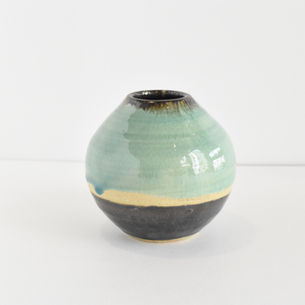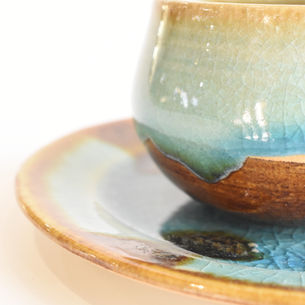RYUKYUYAKI ARTIGIANO

About the product
Product handling
About sealing the experience vessels
How to care for and maintain Yachimun pottery
Okinawan pottery (Yachimun) may become stained, discolored, or smelly when it is first used with strong liquids such as coffee, or after repeated use due to moisture and oils from food and drinks soaking into the pottery.
Ceramics, which are made primarily from clay, are highly absorbent and can absorb water and oil.
There are invisible cracks (crazing) and holes (pinholes) on the surface of pottery.
Moisture and oil will seep in through these areas and through the unglazed surfaces of the base material.
*Cracks and holes caused by crazing or pinholes are not "breaks" and will not affect the use of the product.
"Before using Yachimun"
For daily use, there are ways to prevent moisture and oil from food and beverages from soaking into the fabric.
①Immerse the container in fresh water before use.
②After soaking for about 15 minutes, wipe off any water from the surface of the dish and serve the food.
A vessel that has absorbed fresh water is different from a vessel that has not absorbed fresh water.
This makes it less likely for moisture (broth) or oil to seep in.
If any discoloration occurs after treatment, soaking the item in kitchen bleach can help make the stain less noticeable.
Regarding handling of Yachimun pottery
Caring for Yachimun Pottery
About sealing the experience vessels
How to care for and maintain Yachimun pottery
Okinawan pottery (Yachimun) may become stained, discolored, or smelly when it is first used with strong liquids such as coffee, or after repeated use due to moisture and oils from food and drinks soaking into the pottery.
Ceramics, which are made primarily from clay, are highly absorbent and can absorb water and oil.
There are invisible cracks (crazing) and holes (pinholes) on the surface of pottery.
Moisture and oil will seep in through these areas and through the unglazed surfaces of the base material.
*Cracks and holes caused by crazing or pinholes are not "breaks" and will not affect the use of the product.
"Before using Yachimun"
For daily use, there are ways to prevent moisture and oil from food and beverages from soaking into the fabric.
①Immerse the container in fresh water before use.
②After soaking for about 15 minutes, wipe off any water from the surface of the dish and serve the food.
A vessel that has absorbed fresh water is different from a vessel that has not absorbed fresh water.
This makes it less likely for moisture (broth) or oil to seep in.
If any discoloration occurs after treatment, soaking the item in kitchen bleach can help make the stain less noticeable.
Eye sealing
Sealing procedure
About sealing the experience vessels
How to care for and maintain Yachimun pottery
Okinawan pottery (Yachimun) may become stained, discolored, or smelly when it is first used with strong liquids such as coffee, or after repeated use due to moisture and oils from food and drinks soaking into the pottery.
Ceramics, which are made primarily from clay, are highly absorbent and can absorb water and oil.
There are invisible cracks (crazing) and holes (pinholes) on the surface of pottery.
Moisture and oil will seep in through these areas and through the unglazed surfaces of the base material.
*Cracks and holes caused by crazing or pinholes are not "breaks" and will not affect the use of the product.
"Before using Yachimun"
For daily use, there are ways to prevent moisture and oil from food and beverages from soaking into the fabric.
①Immerse the container in fresh water before use.
②After soaking for about 15 minutes, wipe off any water from the surface of the dish and serve the food.
A vessel that has absorbed fresh water is different from a vessel that has not absorbed fresh water.
This makes it less likely for moisture (broth) or oil to seep in.
If any discoloration occurs after treatment, soaking the item in kitchen bleach can help make the stain less noticeable.






















